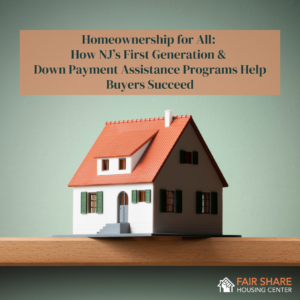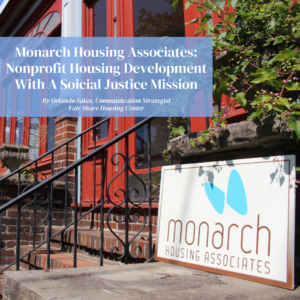New Jersey’s Latinx: Housing, History, and Generational Challenges
September 28th, 2023
By Diego Alejandro Arias, Staff Attorney
New Jersey’s Latinx community has made a vibrant contribution to the state and its growth, development, and regional character. It’s impossible to live in New Jersey and not be witness to the commercial and cultural influences of Latin Americans. Newark and Plainfield’s Ecuadorean small businesses, Elizabeth’s Little Colombia on Morris Avenue, Paterson’s Little Lima, and Perth Amboy’s rich Puerto Rican and Dominican enclaves are a few examples of communities that have shaped New Jersey’s twenty-first century demographics and economy. As of 2023, more than twenty-one percent of the state is Latinx. The numbers only continue to grow. From 2010 to 2020, the Latinx population in New Jersey grew by more than 440,000 new residents. In New Jersey public schools, thirty-two percent of children are from families that identify as Hispanic.
Although they have always played a part in the country’s history, even in the pre-revolutionary war era, many Latin-American immigrants arrived in New Jersey during their first large waves in the early and mid-twentieth century, mostly from Puerto Rico and Cuba. These two countries had easier access to U.S. soil due to their status as an acquired territory or as political refugees fleeing communist regimes during the Cold War. The Latinx, however, are not a monolithic group, and over several decades, immigrants from all over Latin America chose to make New Jersey their home. Some examples of popular enclaves include Mexican Americans in Monmouth County, Cuban Americans in Hudson County, a large Puerto Rican community in Camden, and many Guatemalan Americans in Trenton. As mentioned here and above, there are dozens of neighborhoods across the state with rich, cultural heritages representing all of Latin America’s various ethnicities.
Most Latinx, however, despite these differences, still face significant barriers when moving to the U.S. and New Jersey, specifically. Lack of access to homeownership and the economic capital to purchase real property is one of the structural forces that limits their equal footing in North America. They have been met by gatekeepers who have denied them access to the same benefits afforded to European-Americans. Even the most educated have met barriers, some for the first time in their lives, learning the hard truth of migrating to the United States.
According to the United Health Foundation’s 2022 State Health Report, Hispanic homeownership in New Jersey is only 40.1%, compared to 77% for White Non-Hispanic households. Most Latinx in New Jersey are renters, and rents have been rising steadily every year in the Garden State. In Jersey City alone, one of the most ethnically diverse cities in the country, rents increased an average of 50% in 2021. In a study by rent.com, figures show that rent has been increasing by an average of 30% annually in New Jersey, crushing low-income families seeking new housing units in an already tight marketplace. These factors only continue to add to the already existing housing instability that disproportionately affects people of color.
New Jersey incomes also reveal a stark disparity. Latinx households make about $63,000 a year, while White Non-Hispanic families make an average of around $86,000 annually. This income gap contributes not just to the segregation of families living in different neighborhoods, but also to the resources available to them when raising families and building generational wealth. Without sufficient economic resources, Latinx families are usually priced out of many neighborhoods and unable to pass on the same economic benefits that White households pass on to their children. During times of crisis, such as the 2008 recession and the COVID-19 pandemic, these financial buffers offer socio-economic protections. They help mitigate homelessness and protect workers from periods of unemployment. Additionally, they may provide resources to start businesses, cover rising expenses, or escape hardships that would otherwise become unsustainable to a family with less wealth.
There are solutions to these problems, and they require the political will and legal protections of our state’s constitution and its deeply imbedded rights on an individual’s access to economic opportunity. New Jersey’s Supreme Court has repeatedly upheld the requirement that all municipalities provide their fair share of affordable housing so that all state residents, regardless of race, ethnicity, or social class, have access to affordable housing and economic opportunity. Despite several years of inaction by the Council on Affordable Housing, New Jersey is now building tens of thousands of affordable homes at a never-before-seen rate of construction.
But despite this progress, New Jersey is still facing an alarming shortfall of affordable homes. To bridge that gap we must continue to enforce and safeguard the Mount Laurel Doctrine while also investing in the development and preservation of more affordable homes. The Fiscal Year 2024 budget included historic funding for affordable housing, and we must build on that investment as a first step to a longer-term strategy for housing development and preservation.
The creation of affordable housing alone however is not enough. Discriminatory tenant screening policies, like credit checks and eviction histories, still create barriers to housing for low-income residents and people of color. Limiting how and when these screenings can be used in the rental market, as was successfully accomplished for criminal histories through the Fair Chance in Housing Act, must be addressed to protect tenants access to housing. And finally, we must continue to acknowledge the role that homeownership plays in creating generational wealth and take the lessons learned from the recently established first-generation homeownership program to help shrink the racial wealth gap in our state.
Overall, Latinx families’ aspirations are no different than other groups in New Jersey. They seek opportunities such as good schools for their kids and affordable housing in good neighborhoods. We must take the necessary steps to live up to the promises our state makes to its people: equal access to housing, opportunities, and a real shot at every family’s American dream.






